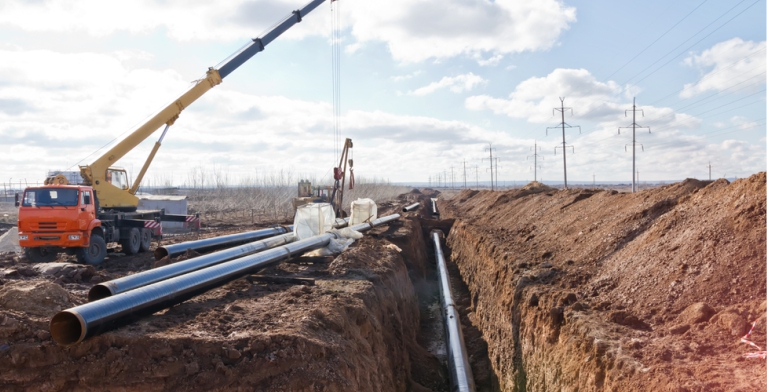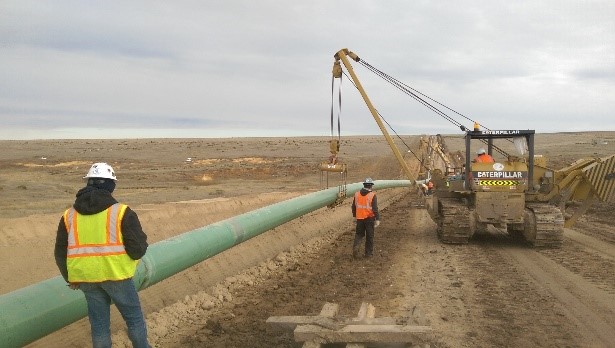Industry Breakdown of Creek Pipe reviews and Customer Experiences
Wiki Article
What You Ought To Understand About Pipe Trenching Solutions: A Comprehensive Overview of Available Options
Pipe trenching solutions are crucial for the installment and maintenance of underground utilities. They involve numerous methods tailored to particular demands and environments. Comprehending these approaches is essential for reliable project execution. Each option provides its own collection of benefits and challenges. As the demand for reliable energy administration increases, knowing what to take into consideration when picking a trenching solution becomes critical. What aspects should one focus on to assure success?Understanding Pipe Trenching: What It Is and Why It Matters
Usually overlooked, pipe trenching is a vital procedure in different construction and energy jobs. This method involves excavating narrow trenches to promote the setup of pipes for water, gas, sewage, and telecoms. The relevance of pipeline trenching depends on its duty in making certain that these necessary systems are appropriately incorporated into framework, allowing the risk-free and efficient distribution of needed services.Proper trenching is vital for maintaining the integrity of pipes and decreasing risks related to dirt disintegration and cave-ins. It also enables reliable assessments and upkeep of underground energies. Additionally, recognizing the neighborhood policies and ecological factors to consider is crucial, as incorrect trenching can bring about costly hold-ups and lawful problems. Inevitably, pipe trenching serves as the foundational action that sustains different construction undertakings, making it a substantial aspect of modern-day infrastructure growth.
Usual Trenching Techniques for Below Ground Utilities
In the domain of underground energies, numerous trenching methods play a crucial role in installation and upkeep - Creek Pipe contact. The open-cut trenching approach, directional boring strategy, and hydro excavation process each offer one-of-a-kind advantages depending on the certain project needs. Understanding these approaches is essential for reliable and reliable energy administrationOpen-Cut Trenching Technique
Open-cut trenching is an extensively made use of technique for installing underground utilities, especially when the deepness and size of the trench enable for efficient access. This technique includes digging deep into a trench along the proposed path of the utility, supplying direct visibility and availability for installation. It is particularly useful for jobs that call for considerable excavation, as it facilitates fast installation and assessment. Nonetheless, it likewise requires mindful planning to decrease interruption to the surrounding area, including website traffic and existing frameworks. Open-cut trenching is most effective in open spaces where the dirt conditions agree with, yet it might be restricted in urban environments due to the visibility of existing energies and various other underground challenges.Directional Boring Technique

Hydro Excavation Refine
How does hydro excavation stand apart among typical trenching techniques for below ground energies? Hydro excavation utilizes high-pressure water and vacuum modern technology to securely eliminate dirt, permitting for precise excavating around sensitive below ground utilities. This approach minimizes the risk of destructive existing facilities contrasted to conventional mechanical excavation. By using water to loosen up the dirt, hydro excavation offers a less invasive approach, decreasing the possibility for dirt compaction and making sure a cleaner worksite. In addition, the process improves presence throughout excavation, boosting total precision and effectiveness. Hydro excavation is especially advantageous in city areas where energy lines are densely loaded, making it a recommended option for specialists focused on safety and security and accuracy in underground projects.Advantages of Trenching Providers
While numerous techniques exist for installing below ground utilities, trenching services offer unique benefits that make them a preferred choice for lots of tasks. One significant advantage is the cost-effectiveness of trenching, as it normally calls for much less specialized tools compared to options like hydro excavation. This commonly causes lower labor and operational prices. Additionally, trenching can accommodate a large range of energy kinds, including water, sewage system, and gas lines, giving flexibility for contractors.Moreover, trenching enables efficient access to several lines in a solitary excavation, minimizing disturbance to the surrounding location. The procedure likewise makes it possible for specific installment and repair, which is crucial for sticking to regulative standards and ensuring long-term reliability. Inevitably, trenching can be carried out fairly rapidly, decreasing project timelines and permitting faster solution restoration. These advantages collectively make trenching services a practical option for several below ground utility jobs.Downsides and Difficulties of Trenching
Despite the many benefits of trenching solutions, there are noteworthy downsides and difficulties that should be thought about. One considerable obstacle is the potential for dirt instability, which can cause collapses, posing threats to workers and devices. In addition, trenching can interfere with existing energy lines, demanding mindful preparation and coordination to stay clear of service interruptions. The procedure can additionally be taxing, specifically in urban locations where area is limited and accessibility is limited. Trenching may call for considerable authorizations and governing conformity, adding intricacy and potential delays to projects. Environmental worries, such as dirt disintegration and damages to local ecosystems, can occur from incorrect trenching techniques. Lastly, the costs connected with trenching, consisting of labor and devices, can escalate if unanticipated problems emerge throughout the job, making it important for stakeholders to weigh these difficulties versus the advantages when taking into consideration trenching solutions.Secret Elements to Take Into Consideration When Choosing a Trenching Service
Selecting the right trenching solution can greatly influence the success of a job. Several essential aspects must be examined to guarantee an ideal choice. The business's experience and knowledge in trenching operations are crucial; a reputable solution with a solid track document is normally extra reputable. Next off, examining the equipment used is essential, as modern-day equipment can enhance effectiveness and accuracy. In addition, it is substantial to take into consideration the variety of services used, consisting of excavation depth and soil type handling, to confirm they fulfill certain task requirements.Another aspect to evaluation is the firm's reputation; client reviews and testimonials can offer insights into previous efficiency. Acquiring thorough quotes that detail costs and timelines will certainly help in spending plan administration. Verifying conformity with regional laws and market criteria is essential for avoiding prospective lawful concerns. By reflecting on these aspects, clients can make an educated choice when selecting a trenching solution.Security Measures in Pipe Trenching
In pipe trenching, safety and security actions are essential to ensuring worker security and site integrity. Secret components consist of using personal protective tools, thorough excavation site evaluations, and well-defined emergency reaction methods. Implementing these actions substantially decreases risks connected with trenching procedures.Personal Safety Tools
Safety and security in pipeline trenching greatly relies upon the appropriate use individual protective equipment (PPE) Workers should use tough hats to safeguard versus falling things, in addition to high-visibility vests to enhance their exposure on-site. Steel-toed boots are vital for foot security against heavy tools and materials. Additionally, handwear covers are essential for hand safety, especially when taking care of harsh or sharp items. Respirators may also be necessary in settings with dirt or unsafe fumes. Eye defense, such as security goggles, ought to be put on to protect against debris. Hearing security is important in noisy job atmospheres. By adhering to PPE standards, workers can considerably lower the threat of injury and guarantee a safer trenching operation.Excavation Site Assessment
Effectively inspecting the excavation site is a basic action in guaranteeing a risk-free pipeline trenching operation. This process involves evaluating the website for potential dangers such as below ground utilities, unsteady dirt conditions, and neighboring frameworks. A comprehensive analysis enables the recognition of dangers that can compromise employee safety. In addition, confirming the soil type and wetness degrees can help establish suitable shoring techniques to protect against trench collapses. It is vital to Creek Pipe reviews ensure that the site is free from particles and that correct signs is displayed to signal workers of recurring procedures. Normal assessments throughout the job can likewise aid detect any kind of changes in website conditions, making it possible for prompt changes to safety and security procedures and work protocols.
Emergency Situation Response Protocols
Emergency situation response methods are important in mitigating threats associated with pipeline trenching operations. These protocols assure that all personnel are prepared to act quickly and effectively in emergency situations. Secret elements consist of routine safety and security drills, clear interaction networks, and designated fire escape. Furthermore, first-aid packages and emergency contact numbers ought to be readily accessible on-site. Trenching procedures must likewise include treatments for taking care of unsafe scenarios, such as cave-ins or utility strikes. Training workers on acknowledging prospective hazards and recognizing their functions throughout an emergency situation is important. In addition, maintaining an updated site safety and security strategy can considerably boost response performance. Overall, efficient emergency situation readiness promotes a much safer working setting and minimizes the impact of unforeseen occurrences.Expense Factors To Consider for Trenching Providers
Recognizing the economic effects of trenching services is vital for task planning and budgeting. The expenses associated with trenching can differ widely based upon numerous factors, consisting of task size, dirt kind, and depth of the trench. Labor expenses frequently stand for a significant portion of the total expenditure, as experienced operators are essential for reliable implementation. Furthermore, equipment service costs can contribute to the overall budget, especially for specialized machinery.Site accessibility is another vital aspect; tough terrain might demand additional sources, increasing prices. Permitting and regulatory compliance can likewise include in costs, especially in city areas where laws are stringent.Lastly, unanticipated issues, such as experiencing existing energies, can lead to unexpected prices and delays. Because of this, getting thorough price quotes from trustworthy trenching solution companies is important for precise budgeting and making sure effective job completion.Frequently Asked Inquiries
The length of time Does a Common Pipe Trenching Task Take?
The duration of a common pipeline trenching job differs substantially based upon variables such as depth, dirt problems, and job complexity. Generally, it can take anywhere from a few days to numerous weeks to finish.What Devices Is Frequently Utilized in Pipe Trenching?

Are There Environmental Rules for Trenching Activities?
Ecological regulations for trenching activities usually require conformity with regional, state, and federal guidelines. These policies aim to reduce environmental disruption, protect water sources, and warranty correct waste management during excavation and installment processes.
Can Trenching Services Be Incorporated With Various Other Construction Tasks?
Trenching services can indeed be incorporated with numerous building and construction jobs. By collaborating initiatives, performances can be achieved, lessening disturbances while making sure that all necessary infrastructure job is finished in a timely and cost-effective fashion.
What Prevail Soil Types Encountered in Trenching?
Typical soil kinds experienced in trenching include clay, sand, silt, and loam. Each kind presents unique obstacles, impacting excavation methods and security, demanding cautious preparation to guarantee risk-free and effective trenching procedures.Report this wiki page